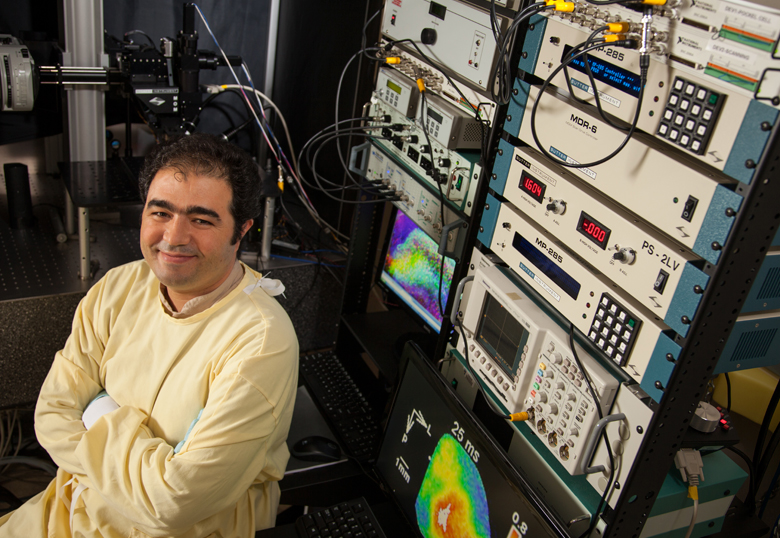A state-of-the-art optical imaging lab in the Canadian Centre for Behavioural Neuroscience (CCBN) is giving University of Lethbridge scientists a leg up in unlocking the secrets of how our brains function. Two-and-a-half years in the making, Mohajerani's lab is hoping to map, with outstanding precision, how the brain repairs itself after a stroke and also provide new insight into neurological disorders such as Alzheimer’s disease.
Having an optical imaging facility, along with the establishment of a population of transgenic mice, will allow Dr. Majid Mohajerani and his colleagues to study the mouse brain in action. This modern rodent-imaging facility is the result of a collective effort that began in 2008 with a major investment of Polaris funds from Alberta Innovates: Health Solutions and the U of L to Dr. Bruce McNaughton and with two infrastructure grants from the Canada Foundation for Innovation to Dr. Rob Sutherland.
Transgenic mice look like ordinary mice but they have been genetically modified. They are used in research because they carry many of the same genes as humans and can be used to study many illnesses, including neurological diseases.

“We know that some of the human brain disorders are caused by a variation or a mutation in a gene or group of genes. In the past 30 years, researchers began to insert human genes into the brain cells of living mice," says Mohajerani. "Using transgenic animals, scientists like me can now try to discover the cause of many diseases, and this may point the way to better treatment of those brain disorders."
With these developments, CCBN researchers will now be able to answer more complicated and detailed questions about what goes on in the brain after an injury like a stroke or in neurological diseases like Alzheimer's.
“One of the topics we are interested in studying is the effect of tiny, ischemic (resulting from inadequate blood supply) strokes on cognitive impairment and dementia. This type of stroke is a common feature of the aging brain. In collaboration with Dr. Rob McDonald's lab, we are studying how these small strokes could potentially drive the progression of Alzheimer's pathology and cognitive impairment. Having a transgenic animal model of Alzheimer's disease is essential to address this question," he says. "This work might potentially lead to new understanding of the link between stroke and Alzheimer's disease."
Neurons can be manipulated using genetic tools to fluoresce in different colours when exposed to light, allowing researchers to gain a better picture of what’s happening in the brain.
"Using this novel combination of genetics, optical imaging and bioengineering, we can watch thousands of neurons over the course of days and months. This will allow us to study how different parts of the brain communicate and work with each other, and how changes in brain circuitry can lead to mental disorders like Alzheimer's disease," says Mohajerani. “I have invested a lot of effort to bring our infrastructure to acceptable levels. We can consider ourselves a world-class neuroscience institution."
The equipment allows researchers to shine a light on a specific area in the brain of a transgenic mouse and activate the neurons involved in a particular function or behaviour, such as running or recalling a familiar memory. Not only will Mohajerani’s research program reveal more information about how the brain functions, but the results will also improve treatments for human patients.
“We don’t know whether the findings we make with mice are necessarily translatable to humans but we don’t have any other choice. We have to try different things and hope to see one of them get translated into actual use in humans,” he says.
Mohajerani can now see how the efforts of the past two-and-a-half years are coming together.
“This would not be possible without the talented people who work with me in this department—my colleagues who are very knowledgeable about brain function, our hard-working students and trainees, and our wonderful animal care staff.
Dr. Michael Kyweriga’s auditory research study details some of the work being done in Mohajerani’s lab.
